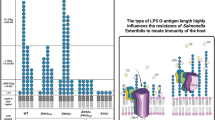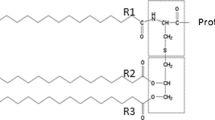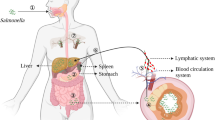Abstract
The adult mouse model was employed to examine the mechanism of virulence enhancement by the extracellular type-specific antigen (ETSA) of type-IIIStreptococcus agalactiae. Intraperitoneal injection of ETSA along with the infecting strain lowered the LD50 value forS. agalactiae and allowed for a more rapid proliferation of the organisms as opposed to that caused by the presence of a nonspecific dextran. The ETSA did not hinder recruitment of peritoneal exudate cells (PEC) into the peritoneal cavity as has been shown with capsular antigens of other bacteria. Chemiluminescent responses of mouse resident PEC demonstrated that these cells could render a respiratory burst when exposed to type-IIIS. agalactiae in the absence of complement and/or type-specific antibody. If the mouse PEC were exposed to ETSA before phagocytosis was attempted, however, ingestion of the type-III group-B streptococci was reduced. ETSA did not affect the viability of the PEC as determined by trypan blue exclusion. These results indicate that the ETSA can affect mouse PEC in an unidentified manner, thus rendering them less capable of ingesting and/or kiling type-IIIS. agalactiae.
Similar content being viewed by others
Literature Cited
Baker, C. J. 1977. Summary of the workshop on perinatal infections due to group B streptococcus. Journal of Infectious Diseases136:137–152.
Baker, C. J., Barret, F. F. 1974. Group B streptococcal infections in infants: the importance of the various serotypes. Journal of the American Medical Association230:1158–1160.
Baker, C. J., Kasper, D. L. 1976. Correlation of maternal antibody deficiency with susceptibility to neonatal group B streptococcal infection. New England Journal of Medicine204:753–756.
Baltimore, R. S., Kasper, D. L., Baker, C. J., Goroff, D. C. 1977. Antigenic specificity of opsonophagocytic antibodies in rabbit antisera to group B streptococci. Journal of Immunology118:673–678.
Doran, T. I., Straus, D. C., Mattingly, S. J. 1980. Extracellular antigens of serotype III group B streptococci. Infection and Immunity30:890–893.
Durham, D. L., Straus, D. C. 1983. Extracellular products of type IIIStreptococcus agalactiae and their relationship to virulence. Current Microbiology8:89–94.
Durham, D. L., Mattingly, S. J., Doran, T. I., Milligan, T. W., Straus, D. C. 1981. Correlation between the production of extracellular substances by type III group B streptococcal strains and virulence in a mouse model. Infection and Immunity34:448–454.
Ferrieri, P., Gray, E. D., Wannamaker, L. W. 1980. Biochemical and immunological characterization of the extracellular nucleases of group B streptococci. Journal of Experimental Medicine151:56–68.
Hellerqvist, C. G., Rojas, J., Green, R. S., Sell, S., Sundell, H., Stahlman, M. T. 1981. Studies on group B β-hemolytic streptococcus. I. Isolation and partial characterization of an extracellular toxin. Pediatric Research15:892–898.
Kato, N., Kato, O., Nakashima, I., Naito, S., Asai, J. 1979. Effect of capsular polysaccharides ofKlebsiella pneumoniae on host resistance to bacterial infection. III. Further study of its effects on interactions between peritoneal leukocytes and virulentSalmonella enteritidis. Microbiology and Immunology23:369–382.
Kjems, E., Perch, B., Henrichsen, J. 1980. Serotypes of group B streptococci and their relation to hyaluronidase production and hydrolysis of salicin. Journal of Clinical Microbiology11:111–113.
Klegerman, M. E., Boyer, K. M., Papierniak, C. K., Levine, L., Gotoff, S. P. 1984. Type-specific capsular antigen is associated with virulence in late-onset group B streptococcal type III disease. Infection and Immunity44:124–129.
Kretschmer, R., Vogel, L. C., Kelly, P., Padnos, D., Goldman, M., Auden, W. M., Gotoff, S. P. 1980. Murine resistance to type III group B streptococci. Infection8:54–57.
Lancefield, R. C., McCarty, M., Everly, W. N. 1975. Multiple mouse-protective antibodies directed against group B streptococci with special reference to antibodies effective against protein antigens. Journal of Experimental Medicine42:165–179.
Milligan, T. W., Straus, D. C., Mattingly, S. J. 1977. Extracellular neuraminidase production by group B streptococci. Infection and Immunity18:189–195.
Milligan, T. W., Baker, C. J., Straus, D. C., Mattingly, S. J. 1978. Association of elevated levels of extracellular neuraminidase with clinical isolates of type III group B streptococci. Infection and Immunity21:738–746.
Ogmundsdottir, H. M., Weir, D. M. 1976. The characteristics of binding ofCorynebacterium parvum to glass-adherent mouse peritoneal exudate cells. Clinical and Experimental Immunology26:334–339.
Ogmundsdottir, H. M., Weir, D. M., Marion, B. P. 1978. Binding of microorganisms to the macrophage plasma membrane, effects of enzymes and periodate. British Journal of Experimental Pathology59:1–7.
Stahl, P., Schesinger, P. H., Sigardson, E., Rodman, J. S., Lee, Y. C. 1980. Receptor mediated pinocytosis of mannose glycoconjuates by macrophages: characterization and evidence for receptor recycling. Cell19:207–215.
Stewardson-Krieger, P. B., Albrandt, K., Nevin, T., Kretschmer, R. R., Gotoff, S. P. 1977. Perinatal immunity to group B beta-hemolytic streptococcus type Ia. Journal of Infectious Diseases136:649–654.
Straus, D. C., Yeung, M. K., Durham, D. L., Mattingly, S. J. 1982. Lack of virulence of bovine type IIIStreptococcus agalactiae strains for mice correlates with reduced in vitro production of extracellular type specific antigen. Current Microbiology7:251–256.
Straus, D. C., Mattingly, S. J., Milligan, T. W., Doran, T. I., Nealon, T. J. 1980. Protease production by clinical isolates of type III group B streptococci. Journal of Clinical Microbiology12:421–425.
Tallarida, R. J., Murray, R. B. 1981. In: Manual of pharmacologic calculations with computer programs, pp. 117–118. New York: Springer-Verlag.
Todd, E. W. 1934. A comparative serological study of streptolysins derived from human and from animal infections with notes on pneumococcal hemolysin, tetanolysin and staphylococcus toxin. Journal of Pathological Bacteriology39:299–321.
Tomita, T., Blumenstock, E., Kanegasaki, S. 1981. Phagocytic and chemiluminescent responses of mouse peritoneal macrophages to living and killedSalmonella typhimurium and other bacteria. Infection and Immunity32:1242–1248.
Weir, D. M., Glass, E., Stewart, J. 1981. Recognition, adherence and phagocytosis. Annals of Immunology (Inst. Pasteur)132D:131–149.
Weir, D. M., Graham, L. M., Ogmundsdottir, H. M. 1979. Binding of mouse peritoneal macrophages to tumor cells by a lectin-like receptor. Journal of Clinical Laboratory Immunology2:51–54.
Wennerstrom, D. C., Schutt, R. W. 1978. Adult mice as a model for early onset group B streptococcal disease. Infection and Immunity19:741–744.
Author information
Authors and Affiliations
Rights and permissions
About this article
Cite this article
Straus, D.C., Diffley, P. The role of type-IIIStreptococcus agalactiae extracellular type-specific antigen in mouse virulence enhancement. Current Microbiology 11, 197–203 (1984). https://doi.org/10.1007/BF01567160
Issue Date:
DOI: https://doi.org/10.1007/BF01567160




